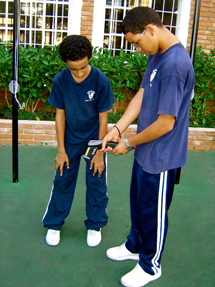Stars and STEM Stories
Participating in the Surface Temperature Field Campaign: Green Walls and “Surf” at the Notre Dame School in the Dominican Republic


measurements of the green playground.
It all started at the 9th Annual GLOBE Conference in Prague, Czech Republic (31 July - 5 August 2005), when GLOBE Partner, Dr. Kevin Czajkowski presented the Surface Temperature Protocol (STP) and the STP project. To participate in the STP project students were asked to compare surface temperature observations from two sites around their schools: one in a large homogeneous grassy field (as large as possible), and the other in a nearby parking lot. The reason this was asked was to compare the difference in the way that grass and paved surfaces change the sun's energy into heat or evapotranspiration.
At that time, Mrs. María de Ruiz-Alma from the Dominican Republic asked Dr. Czajkowski if urban schools could compare the temperature of their paved playgrounds given that they did not have any grassy areas. The idea started a worldwide campaign and the results where unsettling: Temperatures of paved areas were higher by 6 degrees Celsius.
GLOBE teachers in the Notre Dame School, Dominican Republic reported the highest temperatures of the 2005 campaign. They decided to solve this problem and protect their school community by making a change at their school. However, changing the paved surfaces proved to be very difficult and expensive. Instead, the teachers came up with a savvy solution to reduce the surface temperature: They chose to change the surface’s color.
A key characteristic of urban areas is artificial surfaces, which can absorb and store great amounts of heat throughout the day. Roads, roofs, parking lots, playgrounds, and courts are generally dark in color, and thus absorb more heat. (This also contributes to the urban heat island effect. The urban heat island (UHI) phenomenon rises as urbanization increases.)
The school then decided to experiment with different colors. They found that the color white reduced the most heat, but was too reflective -- especially on a sunny tropical island. The school then decided on the color green and called their campaign “Green Surf.”
The green coating on the impervious surfaces reduced the heat by 3 degrees Celsius and also had a psychological cooling effect so great that Notre Dame School students prefered to have lunch on the green paved area.
Not only did the school look more attractive, but this solution was noticed by others in the community and especially when the students would take their weekly surface temperature measurements. The school also then added shrubs, flowering plants and trees to reduce the temperature even more. Later came designers who planted grass on the walls and roofs.
The awareness of the island heat and the cooling effect of the school’s Green Surf influenced schools, businesses, apartments, parking lots, and even the Ministry of Education in the Dominican Republic, who painted their own impervious surfaces. This collective action reduced the temperature even more in the Dominican Republic.
Other communities around the world saw the school’s solution via social media and implemented their own green solutions to reduce surface temperature.
Each time you see green paved areas and grass walls and roofs remember the big contribution that the GLOBE Surface Temperature Campaign gave to the world, creating awareness of heat absorbing surfaces and how we can change our environments to be cooler and a green place.
Learn how you too can participate in the STP campaign, here.
(In order to participate, a teacher needs to be GLOBE trained in the surface temperature protocol and have an infrared (non-contact) thermometer. Infrared thermometers (IRTs) are used in the auto repair, heating and cooling and food preparation industries.)
Editor’s Note: This GLOBE Star was created from a story written and submitted by Gabriel Ruiz.





